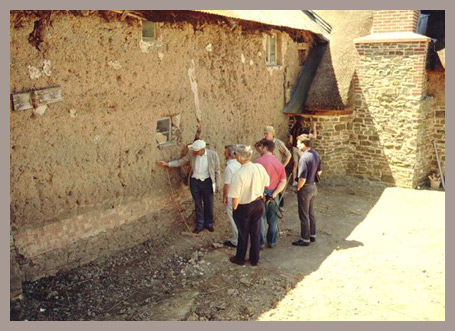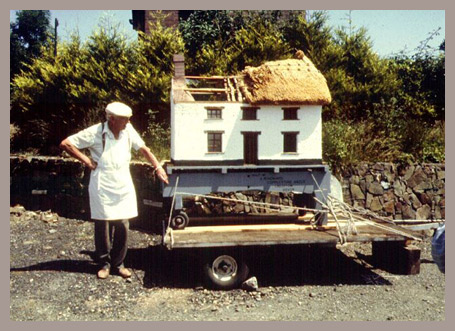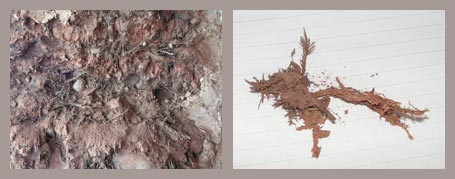Latest News
![]()
Alfie Howard`s Memorial Service
2 o`clock on Saturday 23 July
Down St. Mary`s Church
All Welcome
![]()
In Memoriam - Alfred Howard and the cob building revival.
It was with great sadness that members of DEBA working group learned of the recent death of Alf Howard at his home at Morchard Road in mid-Devon.
Mr Howard, as he preferred to be known, played a crucial and pivotal role in the revival of traditional cob construction for both new build and historic building repair. As a young man in the 1930s Alf worked in his family building business, alongside older men, some of whom had probably been working with cob since around the turn of the century. At the outbreak of war 1n 1939 Alf enlisted in the Royal Engineers and was sent to northern France with the BEF. He was evacuated from Dunkirk in May 1940, a fact of which he was always very proud. He later served in Italy and was present at the battle for Monte Cassino. After the war Alf returned to the family business and also opened a timber yard, which became very successful.

In 1980 he was asked by Down St Mary Parish Council to construct a shelter in the village for children waiting for the school bus. This attractive little building in the village centre was a gift from Alf Howard to the Parish Council. Apart from its roof timbers of seasoned oak, the most remarkable features of the building were its walls, of mass cob built off a cut stone plinth. This was the first example of a new cob building in Devon since the 1930s. It created a lot of interest locally and was featured in the local press. Alf's principal motivation was in keeping the cob building tradition alive by 'showing them how it was done'. Within a fairly short time, once news of his activities spread, Alf was approached by some Devon conservation officers, SPAB and English Heritage with requests to give practical demonstrations of this ancient building technique. He subsequently appeared on both local and national TV programmes, and travelled to various sites, some of which were outside Devon, to give advice on cob construction. Within Devon he gave influential advice at meetings of the Devon Rural Skills Trust.

Having seen many serious cob building failures in his time, Alf was also interested in developing non-invasive, conservative repair techniques and putting them into practice. Over twenty years later, these repair methods are in widespread use by architects, engineers and surveyors in the South West and in other areas of Britain. Alf had a keen intellect but was, above all, a master craftsman, with a profound knowledge of traditional building methods and materials, The lore and wisdom of Alf Howard, his quiet humour, his omnipresent flat cap (winter and summer pattern) and his roll-up ciggies, will long be remembered by all who knew and worked with him, with respect and affection.
Larry Keefe
![]()
Marian Wood writes in response to Heather and gorse (April 2009) alternatives to straw in cob.
My cottage at Cottwood near Riddlecombe (between Ashreigny and Dalton) has far more bracken than straw as a binder. It was built about 1820, one of a development of 12 detached cottages on the edge of a wood.
Before I knew much about cob I remember hacking a doorway through a cob wall at Indiwell, Swimbridge, it was a good metre wide and consisted of the local stone ground very small and mixed with mud and not much else, it was as hard as concrete and took me ages with a hammer and chisel. It could have dated from 16/17c and was topped later with a more conventional cob mix.
Email : outofthewood@live.com
![]()
French Earth Builders visit Devon

French visitors outside Jill’s summerhouse
Early in July DEBA members were visited by a French earth building group ‘Pierre et Masse’ an association interested in the rural heritage of West Normandy.
They stayed in Drewsteignton, a typical cob village on the edge of Dartmoor. During their stay they visited Kevin McCabe’s beautiful cob house at Keppel Gate where they joined in a cob workshop. They spent a delightful afternoon with Chris Shapland at his 1820 cob villa in Dawlish where Chris gave them an informal talk about some of the problems associated with cob buildings. They found the slides fascinating and relevant to some of the repairs they are dealing with in Normandy. Jan and Jerry Sharpe kindly invited the group to their new cob house in Merton and I was able to show them round my 16 century cob farmstead. It is always interesting meeting people from other countries who have a similar passion for earth building and we all really enjoyed discussing the pros and cons of repairs and new build using cob.
Many of the earth buildings in Normandy use the same mass cob techniques we employ here in Devon.
This is a quote from the Pierre et Masse leaflet :-
‘The technique of unbaked mud walls in “bauge” (cob), known locally as “la masse” is particularly found in our houses. This technique is very specific to the zone close to the Marais (marshes) but is also present in the Rennes basin, as well as Eure and Loire. ‘
‘We have lots of ideas as the local Chateaux, Manors and Churches have been widely studied during the decades, but with very little structural work on the rural buildings.
It is apparent to us today for the urgent need to start and try to reproduce this knowledge through visits, training and exhibitions’
For more information about ‘Pierre et Masse’ :-
e mail: pierreetmasse@free.fr
Blog; http://pierremasse.hautetfort.coms
![]()
Heather and gorse

During my work on cob buildings, I have often wondered why other fibrous material other than straw wasn’t used in the making of cob. It appears that other plant material was used. During repair works to the walls of a house in Woodbury, it was noted that instead of using straw in one of the sections of wall, a mixture of heather and gorse appeared to be providing the bulk of the fibrous material. This would seem a logical choice of material as it would have been in plentiful supply on nearby Woodbury Common where furze (gorse) cutting would have been undertaken and may have provided a cheaper alternative to straw or hay. It must have been much more difficult to handle and mix with. The thorns of the gorse were still sharp and left me with splinters. It certainly would not provide a suitable alternative of the bare-footed cob fraternity.
It would be interesting to know if any one else has found similar material used in cob.


